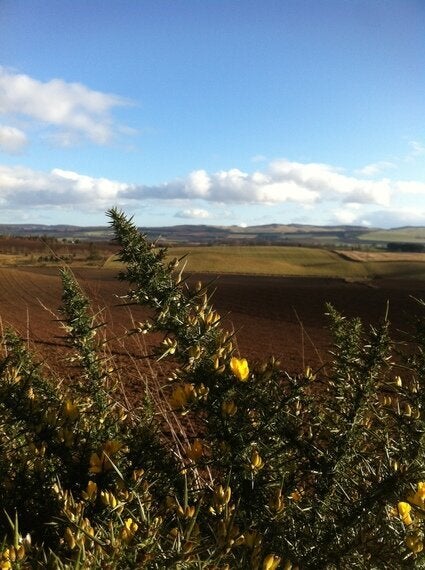The heady coconut scent of a bright yellow gorse bush cheers a dull spring day. It brings a promise of sunshine and to my mind smells of exotic suntan lotion. As the days lengthen, the gorse flower provides pollen and nectar for bees. It's a capricious bloom, flowering again in autumn and often into winter, so the wild cook is ensured a kiss whatever the season. The author Thomas Hardy remarks upon the gorse season in his book The Return Of The Native through the character Clym, the furze (gorse) cutter.

It is said that the eighteen letters in the Gaelic alphabet are associated with a native tree and in mnemonic fashion 'o' Onn is Gorse. Gorse was certainly important for those working on the land beyond its cheery colour and scent, as fodder for sheep and horses. Consumption of gorse was also said to increase the milk yield of cows.
Flower syrups or vinegars are useful for capturing scented hedgerow, woodland and meadow blossom. To make gorse vinegar, simply steep sun warmed gorse flowers in white wine, cider or rice vinegar until the vinegar is yellow and gorse flavoured (it doesn't taste of coconut). Strain the yellow vinegar through a fine nylon sieve or jelly bag (or a paper coffee filter) into a clean jug and pour into sterile bottles. Seal with vinegar proof lids, label and store in a cool, dry place. Gorse buds can be pickled and used as capers (nasturtium fashion). Others may prefer to use the blossom to make gorse tea.
Gorse Water (Taken from The Forager's Kitchen)
I use gorse blossom water to add delicate flavour and colour in icing to use on cakes or cookies but a few fragrant drops from a cold bottle on the face, will refresh a cook on a hot day.
Makes approx 75ml
50g gorse blooms (about 6 large handfuls or ¼ carrier bag) collected in sunshine.
Boiling water to cover the blossom
Rinse the flowers with cold water and strain through a colander. Put a trivet (I use a small, heat resistant ramekin but a metal jam jar lid will suffice) into a pan and heap the blossom around the ramekin. Pour in enough boiling water to cover the gorse flowers. Balance a small, sterile jam jar on the trivet and invert the pan lid to cover. The pan lid needs to sit heavily on the pan without any vent for steam to escape. Heat the pan and when the water boils, put a bowl full of ice cubes (or weigh the lid down with freezer blocks.) As the steam hits the cold lid it condenses and will fall into the jam jar - Presto you have Gorse Water. Replenish the ice or ice block as necessary and heat until the water surrounding the flowers has evaporated and condensed. (About 15 minutes). Remove the jar of gorse water, seal with a lid and refrigerate. Use within a couple of months
You might prefer to steep gorse blossom in boiling water and use the yellow water to make a floral syrup. I usually add sugar to blossom water in a 2:1 ratio e.g. 100gm sugar to 50ml scented water. Dissolve the sugar over a very low heat. Sometimes it will crystallize and the colour fade, so keep floral syrups to the front of store cupboards, where you can keep a watchful eye on any sugar crystal gremlins. When I am baking, I simply throw a handful of gorse flowers into a bowl and cover them with minimal water. Once the water is yellow stained, I strain it and mix it with icing sugar and then ice cup cakes naturally.